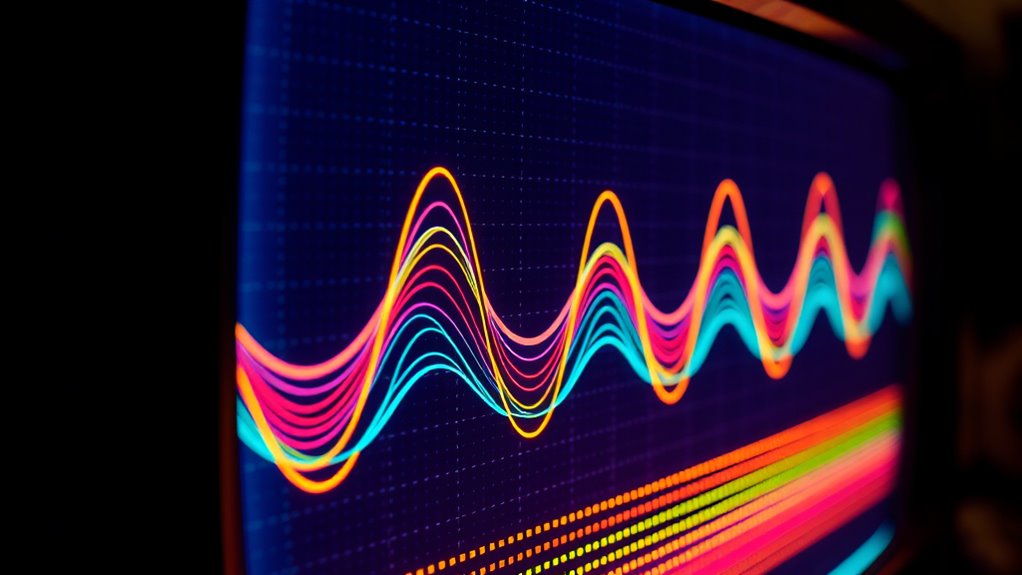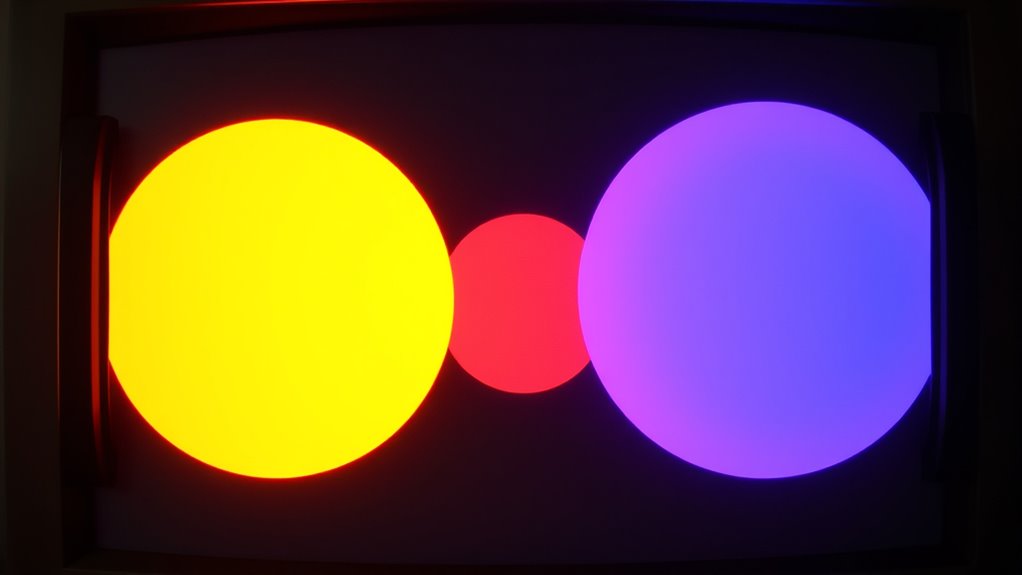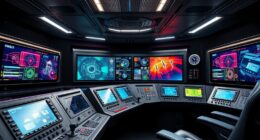Vector monitors are specialized displays that draw images with high precision by directly creating lines, making them ideal for professional, technical, or scientific visuals. They work by converting electrical signals into electron beams that move across a phosphor screen, forming smooth lines and shapes. Unlike raster screens, they produce sharp, scalable images with excellent color accuracy. If you want to understand how these unique monitors operate and their advantages, explore further to discover more.
Key Takeaways
- Vector monitors draw images directly by controlling electron beams to create precise lines and shapes on phosphor screens.
- They convert electrical signals into magnetic deflections, enabling smooth and accurate rendering of complex waveforms.
- Unlike raster displays, vector monitors produce scalable, sharp images with minimal distortion, ideal for technical and scientific visuals.
- They offer vibrant colors and high visual clarity, but can be more costly and prone to geometric distortion with complex images.
- Historically used in arcade games and early computer graphics, their technology influences modern high-precision display systems.
What Are Vector Monitors?

Have you ever wondered how old-school oscilloscopes display complex waveforms? Vector monitors are specialized display devices that visualize analog signals with remarkable accuracy. Unlike traditional oscilloscopes, they can represent both the magnitude and phase of signals, creating detailed vector graphics. These monitors excel at visualizing color capabilities, allowing you to see multiple signals simultaneously in different hues. This color differentiation makes it easier to analyze complex waveforms and identify issues quickly. Vector monitors use electron beams to project images onto a phosphor screen, translating electrical signals into visual patterns. Their ability to handle analog signals and display them vividly makes them invaluable in fields like radar, television, and electronic engineering. They provide a precise, colorful way to interpret intricate signal data visually. GMC tuning techniques highlight the importance of precise signal management in specialized display technology.
How Do Vector Monitors Work?

Vector monitors work by converting electrical signals into precise electron beam movements that form images on the screen. When signals are received, the monitor uses vector calibration to guarantee the electron beam accurately traces lines and shapes. This calibration aligns the electron beam’s position and intensity, producing sharp, clear images. The electron beam is directed by magnetic deflection coils, which respond to the incoming signals, moving the beam along specific paths. Unlike raster displays, vector monitors draw images directly with the electron beam, creating crisp lines and detailed graphics. Proper vector calibration is essential for smooth, accurate images, guaranteeing the electron beam follows the intended paths without distortion. Additionally, the technology was popular for high-quality graphics and technical displays, emphasizing precision over fill rate. This precise control allows vector monitors to produce high-quality visuals, especially for technical or graphical applications.
Components of a Vector Display System

A vector display system mainly depends on a cathode ray tube (CRT) to create images, while signal processing units control the drawing process. The CRT directs the electron beam to specific points on the screen, forming lines and shapes. Signal processing units guarantee the correct signals reach the CRT, making the display accurate and responsive. Understanding the resources and tools available can further enhance the performance and troubleshooting of such systems.
Cathode Ray Tube (CRT)
The Cathode Ray Tube (CRT) serves as the core component of a vector display system, converting electrical signals into visual images. It works by directing an electron beam across the screen, which is coated with phosphor. When the electron beam hits the phosphor coating, it glows, creating a visible point of light. This process allows precise control of the image’s shape and position. Proper storage of the CRT and its components ensures its longevity and optimal performance.
Signal Processing Units
Signal processing units are essential components that interpret and convert input commands into precise control signals for the display. They guarantee accurate rendering of images by managing data flow and timing. These units handle critical functions like color calibration, which guarantees consistent color accuracy, and regulate the power supply to maintain stable operation. Proper signal processing is crucial for smooth vector drawing and minimizing distortions. Additionally, they filter out noise, synchronize signals, and optimize performance. Key aspects include: managing color calibration for accurate color reproduction, regulating power supply to ensure stable voltage and current, and synchronizing signals for precise vector positioning. Effective signal processing also involves noise reduction techniques, which are vital for maintaining high image quality in vector monitors.
Differences Between Vector and Raster Displays

You’ll notice that vector and raster displays use different technologies to create images. These differences affect image resolution and how sharp or clear the visuals appear. Understanding these distinctions helps you choose the right display for your needs. For example, resolution quality varies between the two, with raster displays typically offering higher resolution capabilities suitable for detailed visuals.
Display Technology Types
Have you ever wondered how different display types create images on screens? Vector and raster displays use distinct methods. Vector monitors draw lines directly between points, resulting in sharp, precise images with high color accuracy. They tend to consume less power because they only illuminate necessary pixels, making them efficient for simple graphics. Raster displays, on the other hand, fill the entire screen with tiny dots or pixels, which can lead to higher power consumption and sometimes less accurate color reproduction.
Key differences include:
- Line drawing: Vector monitors create images by plotting lines, while raster displays fill pixels.
- Color accuracy: Vector displays often produce more accurate colors due to their precise line control.
- Power efficiency: Vector monitors typically use less power for simple graphics compared to raster screens.
Image Resolution Differences
When comparing image resolution between vector and raster displays, it’s important to recognize that raster screens typically offer fixed pixel grids, which can limit clarity when scaled or viewed up close. Raster displays rely on pixel density, meaning the number of pixels per inch determines image sharpness. Higher pixel density results in crisper, more detailed images, but scaling can cause pixelation or blurriness. Conversely, vector displays use mathematical equations to define lines and shapes, so their resolution isn’t limited by a fixed pixel grid. This allows vectors to be scaled infinitely without losing image sharpness. While raster images can appear pixelated at larger sizes, vector images maintain clarity regardless of scaling. Understanding these differences helps you choose the appropriate display technology for your specific resolution and sharpness needs. Additionally, resolution independence makes vector displays especially suitable for applications requiring precise and scalable graphics.
Visual Clarity Variations
Why do vector and raster displays differ so noticeably in visual clarity? It mainly comes down to how each type renders images. Vector monitors produce sharp lines by drawing directly with mathematical equations, ensuring high precision and crispness. Raster displays, however, rely on pixel grids, which can cause pixelation or blurriness at certain resolutions. These differences impact:
- Color accuracy, as vector monitors often maintain consistent hues without pixel blending, while raster displays may experience color bleeding.
- Brightness levels, with vector monitors typically offering stable brightness, whereas raster screens can vary depending on pixel quality.
- The clarity of fine details, where vectors excel in rendering smooth, clean lines, contrasting with the potential jaggedness of raster images at lower resolutions. Additionally, the type of display technology influences how well each system handles image rendering, further contributing to their visual distinctions. These factors contribute to the distinct visual experiences of each display type.
Advantages of Using Vector Monitors

Vector monitors offer several key advantages that make them valuable tools in various applications. One major benefit is their superior color accuracy, which guarantees precise and vibrant visuals essential for detailed graphical work, design, and scientific displays. This accuracy helps you rely on consistent, true-to-life colors, enhancing your overall experience. Additionally, vector monitors are known for their energy efficiency. They consume less power compared to other display types, making them a cost-effective choice for long-term use and reducing your environmental impact. Their ability to produce sharp, stable images with minimal power is especially beneficial in professional settings where reliability and performance matter. Furthermore, the increasing focus on AI Security underscores the importance of dependable technology, which vector monitors can provide through their stability and accuracy. Overall, these advantages make vector monitors a smart investment for anyone prioritizing visual quality and energy savings.
Limitations and Challenges of Vector Technology

Despite their advantages, vector monitors face several limitations that can impact their effectiveness. One significant challenge is maintaining color accuracy across different display conditions, which can lead to inconsistent visuals. Additionally, the manufacturing costs are higher compared to raster displays, making them less affordable for widespread use. You might also encounter issues with geometric distortion, especially when displaying complex images or fast-moving graphics. To summarize: – Color accuracy can vary, affecting visual fidelity – Manufacturing costs remain high, limiting accessibility – Geometric distortion may occur with intricate or rapid visuals These challenges restrict their broader adoption, despite their unique strengths in rendering smooth, scalable graphics. Overcoming these hurdles requires ongoing technological advancements and cost reductions. Additionally, display calibration techniques are essential in mitigating color inconsistencies and enhancing performance.
Typical Applications and Historical Significance

While the limitations of vector monitors have restricted their widespread adoption, their unique capabilities have led to notable applications and historical significance. You’ll find that they played a crucial role in early arcade games and computer graphics, offering fast, smooth line drawing that modern raster displays couldn’t match at the time. Their crisp, clear visuals made them ideal for technical and scientific purposes, especially in archival uses, where accurate rendering of complex data was essential. Artists also explored vector monitors for creative expression, using their precise control to produce distinctive visuals and experimental art. Although largely replaced today, their influence remains evident in the development of modern graphics technology. Their legacy highlights a fascinating chapter in display history, emphasizing innovation driven by unique technical strengths.
The Legacy of Vector Monitors in Modern Technology

Although vector monitors have largely been phased out, their influence continues to shape modern technology in subtle but meaningful ways. You can see their legacy in the development of graphical interfaces that prioritize smooth, precise rendering. Their advanced color capabilities helped push the boundaries of visual quality, inspiring subsequent display technologies.
Some key contributions include:
- Foundation for early CAD systems and scientific visualization tools
- Influence on modern vector graphics and digital drawing applications
- Inspiration for high-performance displays in aerospace and defense industries
While CRT vector monitors are gone, their legacy persists in the principles of precise, responsive visual output that modern screens and interfaces still emulate today.
Frequently Asked Questions
How Has Vector Monitor Technology Evolved Over the Decades?
You’ve seen how vector monitor technology has evolved, especially with the analog resurgence. Today, advancements focus on color enhancement, making images brighter and more vivid. Modern designs incorporate better phosphors and circuitry, improving resolution and reducing distortion. You benefit from these innovations through sharper visuals and richer colors, even as digital screens dominate. This evolution keeps vector monitors relevant for enthusiasts and niche applications, blending vintage charm with contemporary performance.
Are Vector Monitors Still Used in Modern Electronics?
You might wonder if vector monitors still find their place in modern electronics. While digital screens dominate today, many enthusiasts cherish CRT displays for retro gaming, especially with vector graphics. You can still see these monitors in arcades or used by collectors who value their unique visual quality. So, yes, they’re still appreciated for specific applications, mainly in nostalgia-driven contexts or specialized equipment, even if they’re no longer mainstream.
What Maintenance Is Required for Optimal Vector Monitor Performance?
Did you know that regular maintenance can extend a vector monitor’s lifespan by up to 30%? To keep it performing at its best, you should regularly perform circuit calibration to guarantee accurate display output. Additionally, keep the screen clean by gently wiping it with a soft, damp cloth to prevent dust buildup. These simple steps help maintain peak performance, ensuring your vector monitor displays clear, precise images every time.
Can Vector Monitors Be Integrated With Contemporary Digital Systems?
You can integrate vector monitors with modern digital systems, but you might face some digital compatibility and integration challenges. These older monitors often require signal conversion or adapters to work seamlessly with current digital outputs. You’ll need to guarantee proper connection interfaces and possibly update some components. Despite these challenges, with the right equipment and technical know-how, you can successfully incorporate vector monitors into contemporary electronic setups.
What Are the Safety Considerations When Operating Vintage Vector Displays?
When operating vintage vector displays, you should prioritize high voltage safety and be aware of electrostatic hazards. Always guarantee the power is off before servicing, avoid touching high-voltage components, and wear insulated gloves if needed. Keep the area dry and well-ventilated, and use proper grounding techniques. Regular inspections help prevent static buildup, reducing electrostatic hazards, and ensuring safe operation of these classic displays.
Conclusion
Like Da Vinci’s sketches that captured imagination, vector monitors showcase a timeless blend of art and technology. Though they’ve given way to modern screens, their sharp lines and precise visuals remind us of a bygone era’s innovation. Embrace the legacy, knowing that behind every vivid line and flicker lies the ingenuity that once pushed boundaries. As with all great artists, their influence continues to inspire future displays, connecting past craftsmanship with tomorrow’s technology.









